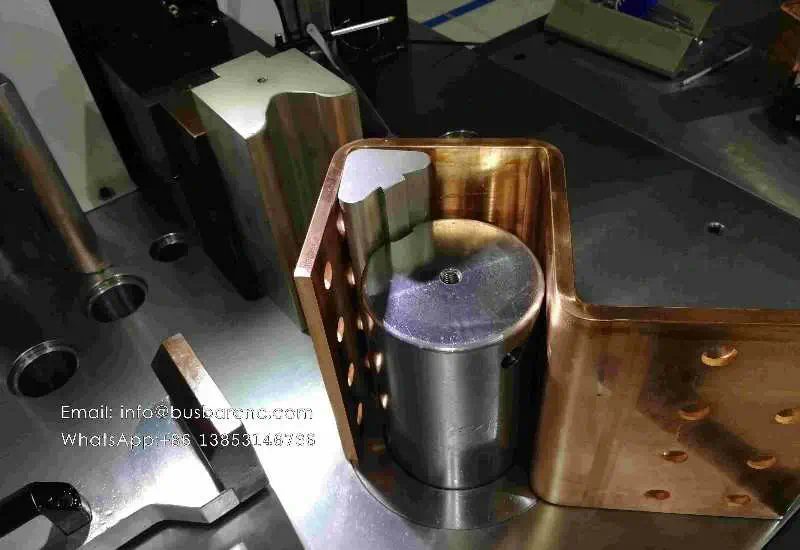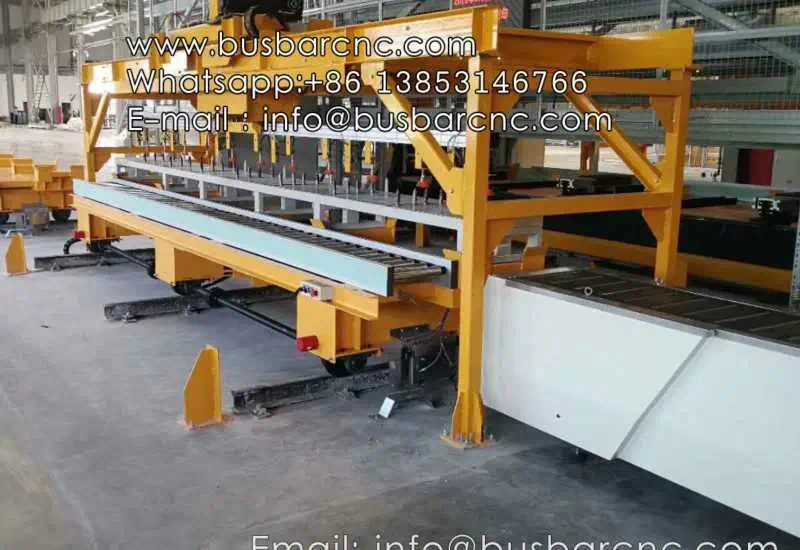Innovations in Busbar Hydraulic Benders: Revolutionizing Electrical Infrastructure
The advancement of technology has brought about significant changes across various industries, and the field of electrical infrastructure is no exception. One area that has seen remarkable innovation in recent years is the development of busbar hydraulic benders. These cutting-edge tools have revolutionized the way electrical busbars are fabricated, offering greater efficiency, precision, and safety in the construction of electrical systems. In this article, we will explore the innovations in busbar hydraulic benders and their impact on the electrical industry.
Busbar Hydraulic Benders: A Game-Changer in Electrical Fabrication
The traditional method of bending and shaping busbars involved manual labor and conventional tools, which often resulted in inaccuracies and inefficiencies. However, the introduction of busbar hydraulic benders has transformed this process, providing a range of benefits that have reshaped the landscape of electrical infrastructure fabrication.
Enhanced Precision and Accuracy
One of the key advantages of busbar hydraulic benders is their ability to achieve precise and accurate bends in the busbar material. The advanced hydraulic systems and computerized controls allow for intricate bending patterns, ensuring that the finished busbars meet exact specifications with minimal margin for error. This level of precision is crucial in electrical systems, where even slight deviations can lead to performance issues and safety concerns.
Improved Efficiency and Productivity
In addition to precision, busbar hydraulic benders offer enhanced efficiency in the fabrication process. The automated bending capabilities reduce the need for manual labor and repetitive tasks, streamlining production and saving valuable time. This increased efficiency translates to higher productivity, allowing manufacturers to meet growing demands for electrical components while maintaining high quality standards.
Versatility in Bending Capabilities
Another notable feature of busbar hydraulic benders is their versatility in bending capabilities. These innovative machines can accommodate various busbar materials, including copper and aluminum, and can produce a wide range of bend angles and shapes. This flexibility enables manufacturers to adapt to diverse project requirements and design busbar embossing machine specifications, ultimately expanding the possibilities for customized electrical solutions.
Safety and Ergonomics
The safety of workers is a top priority in any industrial setting, and busbar hydraulic benders have been designed with this in mind. These machines minimize the physical strain associated with manual bending processes, reducing the risk of injuries and improving overall ergonomics for operators. By automating repetitive and potentially hazardous tasks, busbar hydraulic benders contribute to a safer working environment.
Environmental Considerations
Beyond their operational benefits, busbar hydraulic benders also address environmental concerns by optimizing material usage and waste reduction. The precise bending capabilities minimize material scrap and offcuts, contributing to sustainable manufacturing practices. Additionally, the energy-efficient design of hydraulic systems aligns with efforts to reduce energy consumption and promote eco-friendly operations in the electrical industry.
Integration of Advanced Technologies
The evolution of busbar hydraulic benders is closely linked to the integration of advanced technologies, such as computer numerical control (CNC) systems and digital interface capabilities. These features enable precise programming of bending parameters, real-time monitoring of the fabrication process, and seamless integration with CAD/CAM software for design optimization. As a result, manufacturers can leverage these technological advancements to achieve greater control and customization in busbar fabrication.
Challenges and Opportunities in Adoption
While the benefits of busbar hydraulic benders are clear, their widespread adoption presents both challenges and opportunities for the electrical industry. Manufacturers and fabricators may face initial investment costs and the need for specialized training to operate and maintain these advanced machines. However, the long-term advantages in terms of improved productivity, quality, and market competitiveness make a compelling case for embracing this innovative technology.
Moreover, the rise of smart grid systems, renewable energy integration, and electrification trends in various sectors creates new opportunities for busbar hydraulic benders. As the demand for efficient and reliable electrical infrastructure continues to grow, the role of advanced fabrication tools becomes increasingly indispensable in meeting industry requirements and driving progress in power distribution and utilization.
Looking Ahead: The Future of Busbar Hydraulic Benders
As technology continues to evolve, the future of busbar hydraulic benders holds promise for further advancements. It is anticipated that ongoing research and development will focus on refining bending capabilities, integrating additional automation features, and enhancing connectivity with digital manufacturing systems. Furthermore, the potential for virtual and augmented reality applications in training and simulation for busbar fabrication represents an exciting frontier for the industry.
In conclusion, the innovations in busbar hydraulic benders have brought about a transformative shift in the electrical infrastructure landscape, offering unparalleled precision, efficiency, and safety in busbar fabrication. With their ability to meet the evolving needs of the electrical industry, these advanced machines are poised to play a central role in shaping the future of electrical infrastructure and powering the next generation of technological advancements.
Innovations in Busbar Hydraulic Benders: Revolutionizing Electrical Infrastructure
The advancement of technology has brought about significant changes across various industries, and the field of electrical infrastructure is no exception. One area that has seen remarkable innovation in recent years is the development of busbar hydraulic benders. These cutting-edge tools have revolutionized the way electrical busbars are fabricated, offering greater efficiency, precision, and safety in the construction of electrical systems. In this article, we will explore the innovations in busbar hydraulic benders and their impact on the electrical industry.
Busbar Hydraulic Benders: A Game-Changer in Electrical Fabrication
The traditional method of bending and shaping busbars involved manual labor and conventional tools, which often resulted in inaccuracies and inefficiencies. However, the introduction of busbar hydraulic benders has transformed this process, providing a range of benefits that have reshaped the landscape of electrical infrastructure fabrication.
Enhanced Precision and Accuracy
One of the key advantages of busbar hydraulic benders is their ability to achieve precise and accurate bends in the busbar material. The advanced hydraulic systems and computerized controls allow for intricate bending patterns, ensuring that the finished busbars meet exact specifications with minimal margin for error. This level of precision is crucial in electrical systems, where even slight deviations can lead to performance issues and safety concerns.
Improved Efficiency and Productivity
In addition to precision, busbar hydraulic benders offer enhanced efficiency in the fabrication process. The automated bending capabilities reduce the need for manual labor and repetitive tasks, streamlining production and saving valuable time. This increased efficiency translates to higher productivity, allowing manufacturers to meet growing demands for electrical components while maintaining high quality standards.
Versatility in Bending Capabilities
Another notable feature of busbar hydraulic benders is their versatility in bending capabilities. These innovative machines can accommodate various busbar materials, including copper and aluminum, and can produce a wide range of bend angles and shapes. This flexibility enables manufacturers to adapt to diverse project requirements and design specifications, ultimately expanding the possibilities for customized electrical solutions.
Safety and Ergonomics

The safety of workers is a top priority in any industrial setting, and busbar hydraulic benders have been designed with this in mind. These machines minimize the physical strain associated with manual bending processes, reducing the risk of injuries and improving overall ergonomics for operators. By automating repetitive and potentially hazardous tasks, busbar hydraulic benders contribute to a safer working environment.
Environmental Considerations
Beyond their operational benefits, busbar hydraulic benders also address environmental concerns by optimizing material usage and waste reduction. The precise bending capabilities minimize material scrap and offcuts, contributing to sustainable manufacturing practices. Additionally, the energy-efficient design of hydraulic systems aligns with efforts to reduce energy consumption and promote eco-friendly operations in the electrical industry.
Integration of Advanced Technologies
The evolution of busbar hydraulic benders is closely linked to the integration of advanced technologies, such as computer numerical control (CNC) systems and digital interface capabilities. These features enable precise programming of bending parameters, real-time monitoring of the fabrication process, and seamless integration with CAD/CAM software for design optimization. As a result, manufacturers can leverage these technological advancements to achieve greater control and customization in busbar fabrication.
Challenges and Opportunities in Adoption
While the benefits of busbar hydraulic benders are clear, their widespread adoption presents both challenges and opportunities for the electrical industry. Manufacturers and fabricators may face initial investment costs and the need for specialized training to operate and maintain these advanced machines. However, the long-term advantages in terms of improved productivity, quality, and market competitiveness make a compelling case for embracing this innovative technology.

Moreover, the rise of smart grid systems, renewable energy integration, and electrification trends in various sectors creates new opportunities for busbar hydraulic benders. As the demand for efficient and reliable electrical infrastructure continues to grow, the role of advanced fabrication tools becomes increasingly indispensable in meeting industry requirements and driving progress in power distribution and utilization.

Looking Ahead: The Future of Busbar Hydraulic Benders
As technology continues to evolve, the future of busbar hydraulic benders holds promise for further advancements. It is anticipated that ongoing research and development will focus on refining bending capabilities, integrating additional automation features, and enhancing connectivity with digital manufacturing systems. Furthermore, the potential for virtual and augmented reality applications in training and simulation for busbar fabrication represents an exciting frontier for the industry.
In conclusion, the innovations in busbar hydraulic benders have brought about a transformative shift in the electrical infrastructure landscape, offering unparalleled precision, efficiency, and safety in busbar fabrication. With their ability to meet the evolving needs of the electrical industry, these advanced machines are poised to play a central role in shaping the future of electrical infrastructure and powering the next generation of technological advancements.




